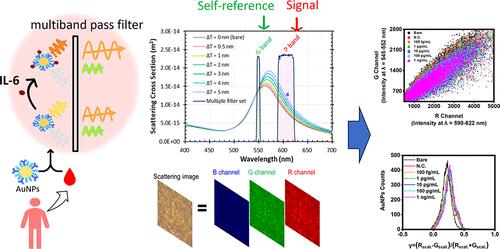Self-referenced Digital Spectral Chromatic Local Surface Plasmon Resonance in Ultrasensitive Severe Sepsis Interleukin-6 Detection
IF 9.1
1区 化学
Q1 CHEMISTRY, ANALYTICAL
引用次数: 0
Abstract
Clinical monitoring of cytokines, such as interleukin-6 (IL-6), enables a timely diagnosis and can significantly improve patient prognosis. In this study, we developed a rapid, label-free, ultrasensitive, and low matrix-effect method called chromatic digital nanoplasmon-metry (cDiNM) to detect IL-6 in human blood plasma. Utilizing a multiple filter configuration, two nonadjacent specific transmission wavelength bands are extracted. One is centered within the full-width-at-half-maximum (fwhm) range where the local surface plasmon resonance (LSPR) response of the 80 nm gold nanoparticles (AuNPs) is strongest, while the other band is narrowed and blue-shifted from the peak to a region with minor intensity change. Scattering images of AuNPs passing through these two bands are then captured simultaneously and independently via the red and green channels of a color scientific complementary metal–oxide–semiconductor (sCMOS) camera. This configuration allows every AuNPs’ spectral chromatic image contrast to be a self-referenced subtractive analysis LSPR and facilitates evaluation of their changes induced by the IL-6 binding across numerous individual AuNPs. This method achieves IL-6 detection in blood plasma within 45 min, requiring only 0.5 mL of a 10-fold diluted, label-free sample, with a limit of detection and quantification (LOD and LOQ) of less than 19.2 and 87.8 fg/mL, respectively, and a recovery rate of 96%. In summary, cDiNM provides rapid and accurate IL-6 monitoring with promising potential for clinical application in sepsis patient care.

自参数字光谱彩色局部表面等离子体共振在超灵敏严重脓毒症白细胞介素-6检测中的应用
临床监测白细胞介素-6 (IL-6)等细胞因子,可以及时诊断并显著改善患者预后。在这项研究中,我们开发了一种快速、无标记、超灵敏、低基质效应的方法,称为彩色数字纳米等离子体法(cDiNM),用于检测人血浆中的IL-6。利用多滤波器配置,提取两个非相邻的特定传输波长带。其中一个带集中在80 nm金纳米粒子(AuNPs)局部表面等离子体共振(LSPR)响应最强的全宽度-半最大值(fwhm)范围内,而另一个带变窄并从峰值蓝移到强度变化较小的区域。通过这两个波段的aunp散射图像,然后通过彩色科学互补金属氧化物半导体(sCMOS)相机的红色和绿色通道同时独立地捕获。这种配置允许每个AuNPs的光谱色度图像对比度成为一个自我参考的减法分析LSPR,并有助于评估它们在多个单独的AuNPs上由IL-6结合引起的变化。该方法可在45 min内检测血浆中的IL-6,仅需0.5 mL 10倍稀释的无标记样品,检测限和定量限(LOD和LOQ)分别小于19.2和87.8 fg/mL,回收率为96%。综上所述,cDiNM提供了快速准确的IL-6监测,在脓毒症患者的临床护理中具有很大的应用潜力。
本文章由计算机程序翻译,如有差异,请以英文原文为准。
求助全文
约1分钟内获得全文
求助全文
来源期刊

ACS Sensors
Chemical Engineering-Bioengineering
CiteScore
14.50
自引率
3.40%
发文量
372
期刊介绍:
ACS Sensors is a peer-reviewed research journal that focuses on the dissemination of new and original knowledge in the field of sensor science, particularly those that selectively sense chemical or biological species or processes. The journal covers a broad range of topics, including but not limited to biosensors, chemical sensors, gas sensors, intracellular sensors, single molecule sensors, cell chips, and microfluidic devices. It aims to publish articles that address conceptual advances in sensing technology applicable to various types of analytes or application papers that report on the use of existing sensing concepts in new ways or for new analytes.
 求助内容:
求助内容: 应助结果提醒方式:
应助结果提醒方式:


